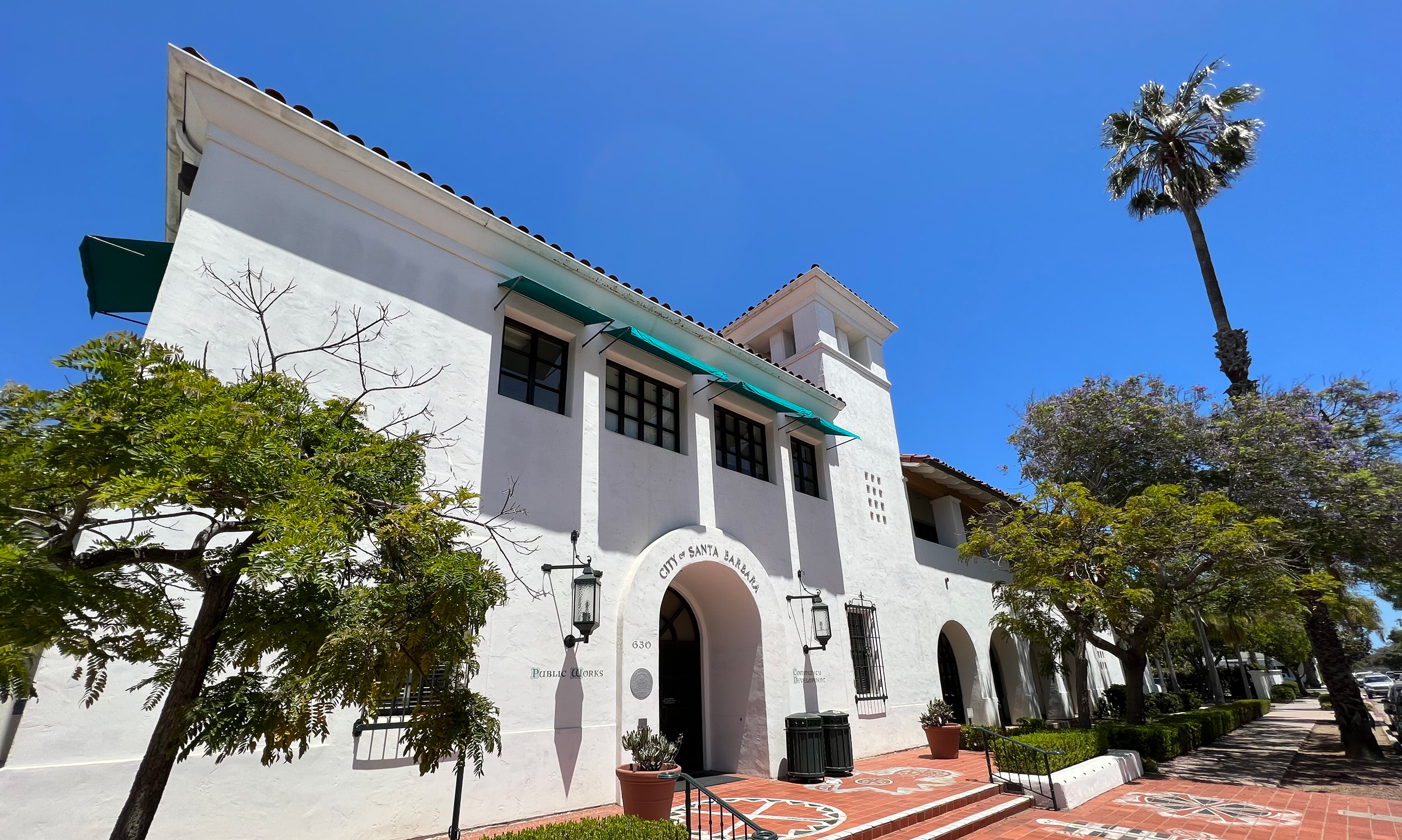
SANTA BARBARA KEEPS ITS BUILDING & SAFETY DIVISION INSPECTORS BUSY DESPITE THERE BEING LITTLE ROOM FOR NEW CONSTRUCTION
With its near-perfect weather and location on the West Coast just a couple hours north of Los Angeles, Santa Barbara is among the most desirable places to live and work in the United States, if not the world. The 42-square-mile city — more than half of which is water — lies between the Santa Ynez Mountains and the Pacific Ocean, providing picturesque views throughout the city.
Predictably, tourism is a major source of revenue for the city, which draws more than 7 million visitors each year, as is the service industry. Santa Barbara is also home to four colleges/universities, and other major employers and industries include local government, health care, agriculture, manufacturing and technology.
The scenic landscape carries its share of risks and problems, among them the older homes on a ridge that runs from east to west and is known as the Riviera. Some of the mountains are in a slide district in which the amount of building that is allowed is limited. In January 2018, a mudslide in the unincorporated Santa Barbara County of town of Montecito that followed a series of wildfires killed 23 people, destroyed dozens of homes and damaged hundreds more. Additionally, high winds coming off the ocean can present problems, and salt water erodes buildings.

PHOTOS BY GEOFF BILAU
The Building & Safety Division is part of the city’s Community Development Department and provides plan review, building inspections and code compliance, among other services, to ensure plumbing, mechanical and electrical work is done in compliance with applicable codes. This includes the California Plumbing Code and the California Mechanical Code, which are based on IAPMO’s Uniform Codes, as well as the California Building Code. Building & Safety Inspection and Plan Check Supervisor Tim Dunn oversees the staff of combination inspectors, each of whom has a particular coverage area.
Dunn said thanks in large part to IAPMO’s staff, there has never been an issue harmonizing the Uniform Codes with the California Building Code.
“If we ever have a problem with anything, or we are looking for an interpretation — that’s key for Building & Safety — I’ve never had a problem reaching or contacting IAPMO staff for an interpretation on the plumbing or mechanical code,” he said. “That’s huge. Every city and jurisdiction I’ve worked, we’ve always used the Uniform Plumbing Code and Uniform Mechanical Code. And for us it’s always been the best code to use.”
Dunn said given the proximity to the ocean, the state looks to Santa Barbara for storm water, and Building & Safety is responsible for monitoring grading drainage of water that comes off residential and commercial properties.
“It’s pretty big for us,” he said. “We get concerned complaints from citizens about runoff from one property to another, especially on sloped hillsides. And nowadays, just soil is considered a contaminant.”
The Pandemic
Like agencies throughout the United States and the world, the COVID-19 pandemic forced the department to change how it operated in the name of safety and complying with mandates. Santa Barbara, however, was out in front of things. Dunn said in late February 2020, the building official directed the department to figure out how to conduct remote inspections, and the team put together policies, procedures and guidelines for contractors, architects and engineers to use for remote inspections.
“We did not miss a beat where some cities, their Building & Safety divisions shut down,” he said. “It was not like that here in the city of Santa Barbara. The city had a strong economy from about 2015 up to COVID — and COVID was a blip and it did slow down projects — but I want to say that within two weeks we had figured out a virtual remote inspection system and we started using it in March.”
The city still conducts what it calls “non-complex” inspections remotely, but the more complicated ones are done in person.
Because the office was not set up for inspectors to be at least 6 feet apart in keeping with state and federal guidelines, employees worked remotely through the pandemic. They recently returned to the office on a hybrid schedule, working from home two days per week.
Further complicating matters was the fact that a citywide computer systems upgrade was underway when the pandemic hit, which sped up the transition to digital-only plans. Dunn said this has been a big hit with architects, who primarily submit plans.
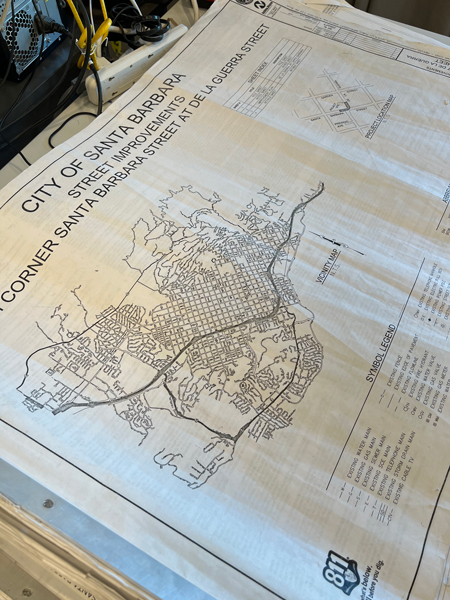
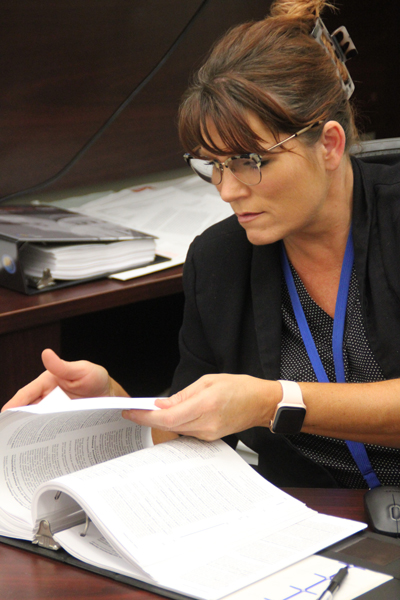

Although the city has mostly transitioned to digital plans, paper remains an option.
Help Wanted
Dunn said before the COVID-19 pandemic, the city was conducting 100-120 inspections per day, some of which had to be done by code enforcement officers. They are now at a more manageable 50-60 inspections each day. However, because the city has openings for three inspectors, employees are covering larger areas than they normally would and working longer hours. He said this problem is not limited to Santa Barbara.
“I’ve been on three different cities’ hiring panels or boards this year, and nobody’s getting more than three or four people applying for jobs because there are more jobs than there are people to fill them,” Dunn said.
He attributes this to the more demanding nature of the job, which has become more technical over the years due to technology and different software programs that are involved as well as the number of certifications that are required.
“They are expected to know every one of the code books you see in front of you for the state of California, plus the municipal ordinance,” he said. “And there are different ordinances from different departments within the city.”
In addition to becoming well-versed in plumbing, mechanical, electrical, energy and building codes for commercial and residential buildings, each inspector must know the fire codes within those disciplines as well as state storm water standards.
“It can be overwhelming, but a well-trained inspector will be able to take care of his or her area,” he said. “And it’s a very gratifying line of work.”
Education is Key
Dunn turned out as a pipefitter after completing a five-year apprenticeship with UA Local 484 in nearby Ventura, where he worked for both the city and county. He then worked for the city of Thousand Oaks before coming to Santa Barbara. He credited his apprenticeship with providing him the wealth of knowledge to prepare him for those positions.
“For plumbing and mechanical inspectors, the best education you can get is an education from an apprenticeship, where you have to go to school for five years and become a journeyman,” he said. “And I think that is what helped me facilitate getting a job is because the Building & Safety departments consider those apprenticeship programs to be the best for education.”
Dunn said the people who make up the Building & Safety Division are the department’s biggest strength. This has come from recruiting and interviewing people from across the United States for positions.
“We look for the best and we want to retain the best in a family atmosphere,” he said.
“So that is our strength, our people. And we are willing to go out of our way to keep people here.” Because additional help is sometimes required for more complicated inspections, the department has specialists for each discipline. The specialists are also area inspectors.
“There are going to be complex projects where they may need assistance,” Dunn said, “the building inspector, and ask for help for, ‘I’ve never seen this type of boiler before; I need the plumbing-mechanical specialist to come out to take a look at it.’ ‘I’ve never seen a 46,000-volt transformer; I need the electrical specialist.’ ‘I’ve never done a parking structure for accessibility.’”
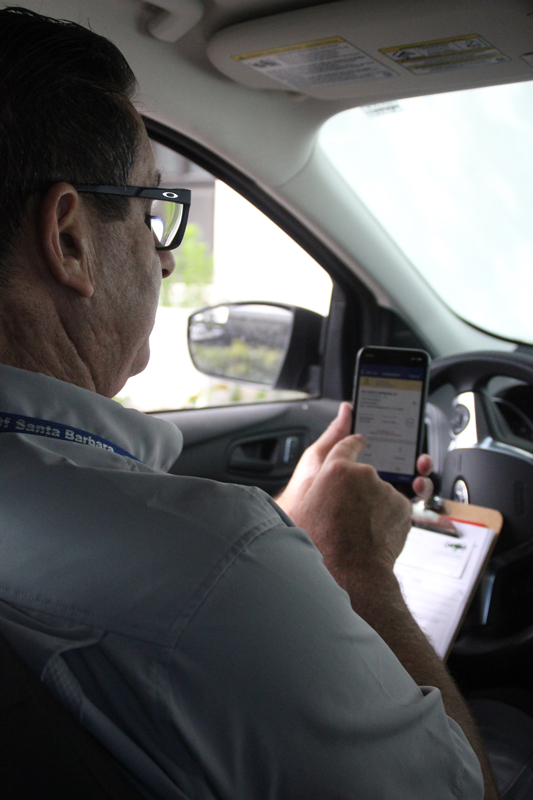

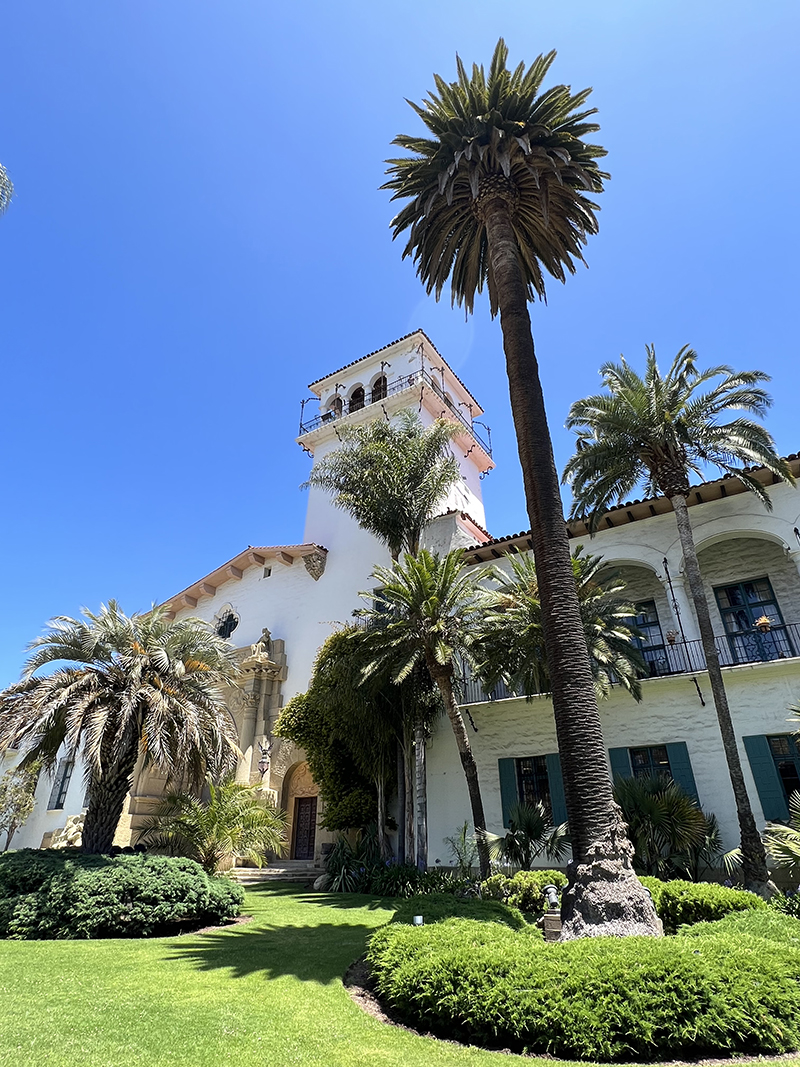
‘Infill City’
Dunn describes Santa Barbara as more of an “infill city” due to the lack of available space for new construction projects. Consequently, developers are renovating hotels and motels.
“Being an older city, we don’t have a lot of free land,” he said. “So they’re gentrifying old hotels and making them very nice. You will have old hotels that were run down because they were built in the 1950s, and now with the economic boon, folks are turning these into $500, $1,000 a night for a room.”
Due to strict regulations about maintaining the city’s historical fabric, there are contractors who specialize in such projects. Residents also take a great deal of pride in their beloved city, and this results in a high level of community involvement and the need for a large team of employees within the department to interact with them and address their concerns and complaints.
“Folks put a lot of money into donations here in the city,” he said. “People are very involved, and that’s why we have such a large staff in Community Development. The city of Santa Barbara has an elaborate municipal ordinance because the public is very concerned about the direction the city is moving in and they want to make sure that they keep it clean — the environment, water, air, trees, and animals.”
To reduce greenhouse gas emissions related to new buildings, the City Council in July 2021 joined nearly 50 jurisdictions in California by voting unanimously to ban the installation of natural gas appliances in new construction projects for permits issued after Jan. 1, 2022. Exceptions will be granted in cases in which it is physically infeasible; it is in the public interest to do so; for cooking appliances for commercial kitchens in restaurants or institutional cooking facilities; and/or laboratory equipment or clean rooms in buildings designed for scientific or medical uses.
THE TOUR
Dunn led Official on a tour through the city that included stops at several inspection sites — a newly finished apartment complex, a renovated high-end hotel, and the conversion of a Dunkin Donuts into a popular Mexican restaurant chain.
800 Santa Barbara
The first stop was at a new 23-unit, three-story luxury apartment complex located two blocks from the city’s popular downtown area on State Street.
The complex features studio, one-, two- and three-bedroom floor plans with private patios, as well as commercial space on the ground floor.
Starting in the underground parking garage, Dunn pointed to the waste and vent lines overhead, as well as fire stopping technology.
“We have these fire penetrations through here,” he said, “which is super important with plumbing so the fire and smoke don’t go up to the residences if we have a fire here.”
Dunn also pointed out the mechanical system in the garage as well as the ventilation system that runs continuously to protect people from, among other things, carbon monoxide.
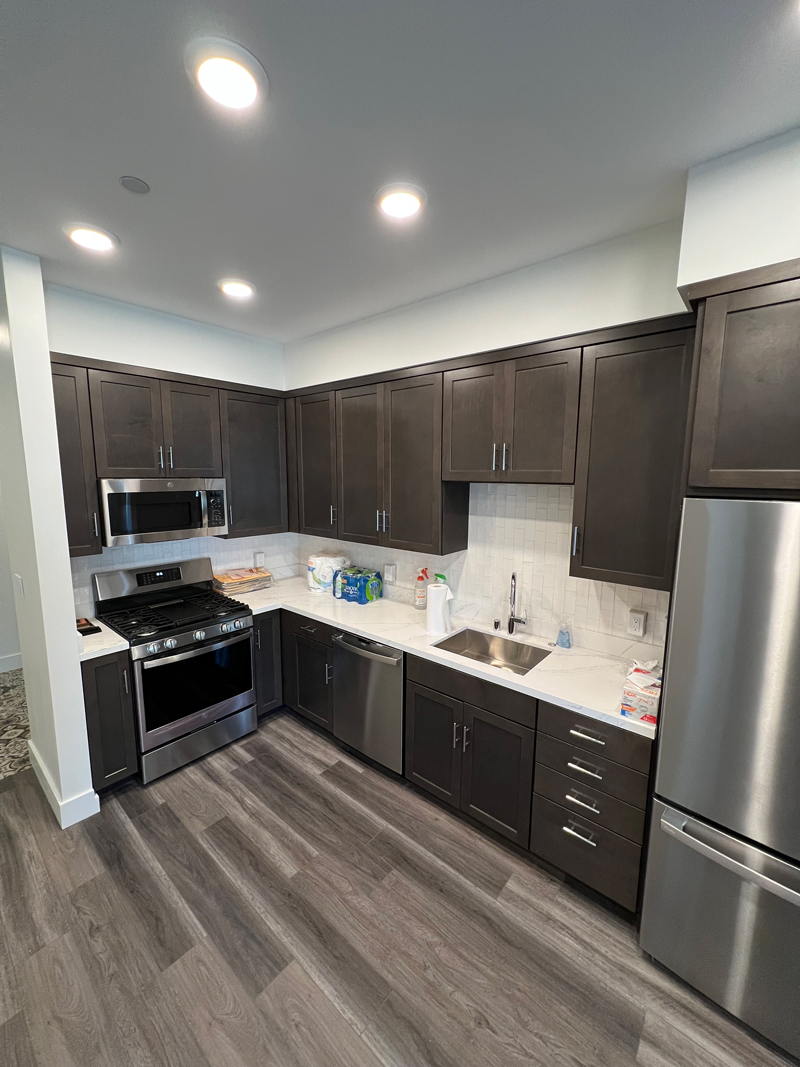
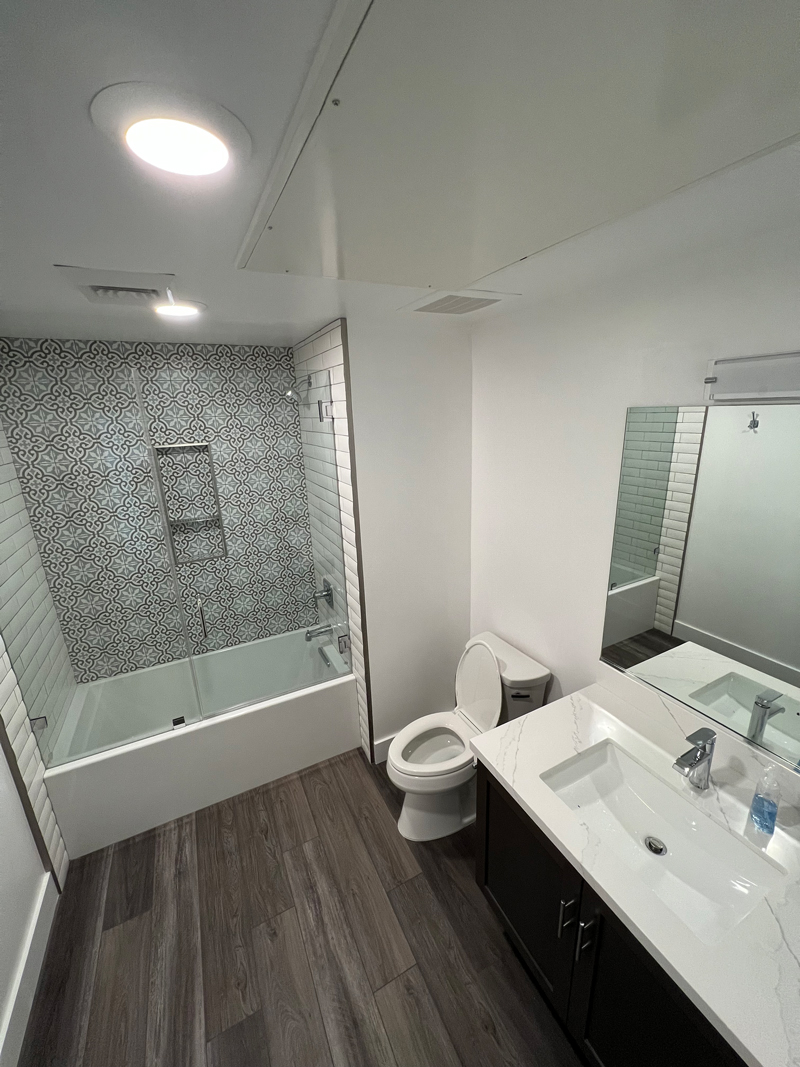
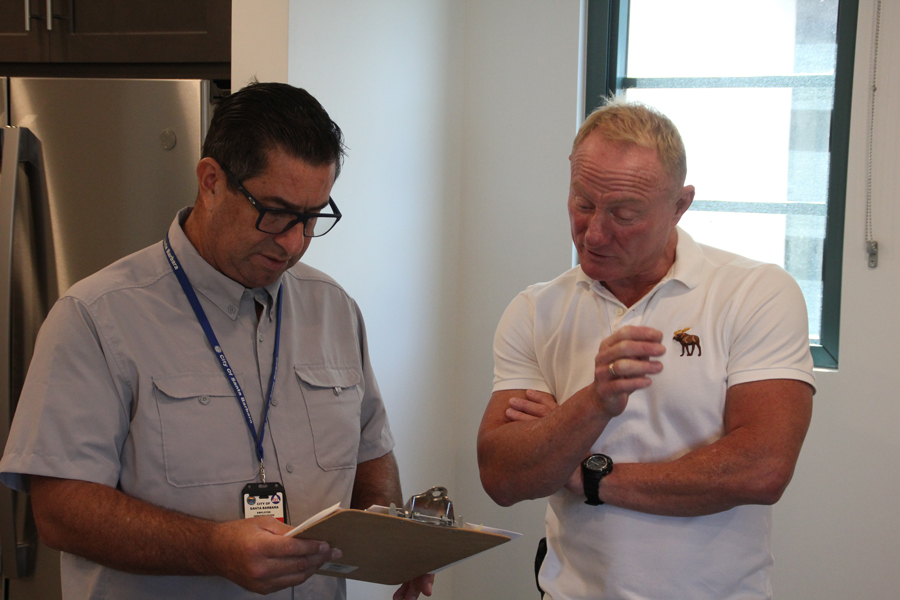
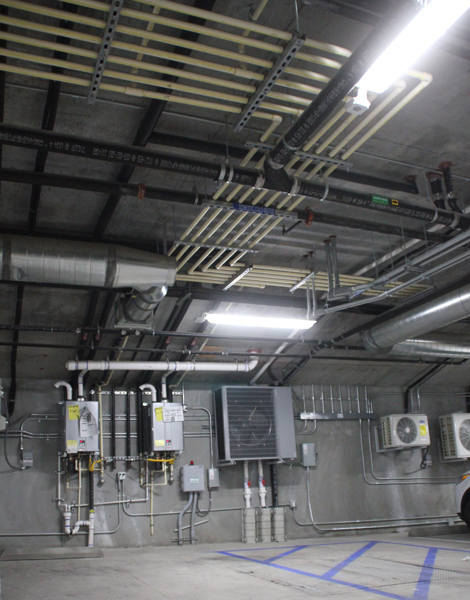
“This is a lot of work and this is excellent work for mechanical systems,” he said. “People get sick on carbon monoxide, and if we didn’t have a properly ventilated garage like this, then over the years carbon monoxide gives you brain damage and makes you sick.”
The garage also contained energy-efficient tankless water heaters and heat pumps for air conditioning.
“Everybody’s going to the mini-split systems, so they’ll have refrigeration lines run to coils that are run to each unit, and it uses less electricity,” he said.
Superintendent Matthew Smithlin with JDC Construction + Development Group is overseeing construction for the project, which replaced a pair of small houses.
Dunn said because the area was once inhabited by Native Americans and there was the potential for artifacts to be uncovered, the city’s archeological team was brought in whenever digging took place.
“We had a specialist who documented everything and then reported their findings,” he said. “In the event they found something, I believe it was turned over to either the Chumash or possibly the museum.”
Smithlin said that while there are always challenges in construction, this project has been fairly straightforward.
“This is a very detailed building,” he said. “Although there are 23 units, it’s like 23 custom homes. It’s not like a square. I just finished a 48-unit building that was a rectangle, and everything stacks so it makes things easy for all your MEPs (mechanical, electrical, plumbing). This unit’s a little more challenging because not everything stacks so it made it more complex.”
Dunn said because the construction had been finished and all that remained was an outstanding item from Public Works, the city would issue a Temporary Certificate of Occupancy for the project, allowing some of the units to be released and occupied.
“For a temporary occupancy, you must have all your life-safety features completed and all the accessibility completed,” he said. “You may have some items that are outstanding that need to be completed. It’s just another measure of trying to help out and be a team player with our contractors, architects and business owners.”
DRIFT
The next stop was less than half a mile away, at a new boutique hotel called Drift on 524 State St. Originally constructed as a businessman’s hotel in 1901 with rooms ranging from 160 to 180 square feet, it was most recently a church until being purchased and converted back.
Mark Edwards, president of Parton-Edwards Construction, Inc., which is building the hotel, said the original plan was to fix the existing brick exterior, but the bricks and mortar had deteriorated so much over time that they would not support a new building. He said the exterior shell was originally about four bricks wide on the ground floor and then about three bricks wide on the second and third floors, and were probably not a very high grade.
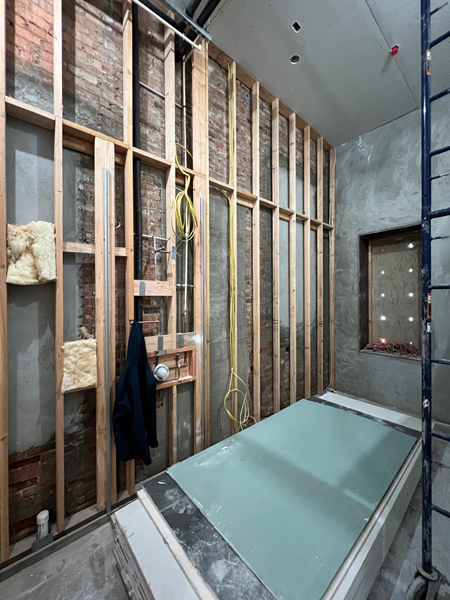
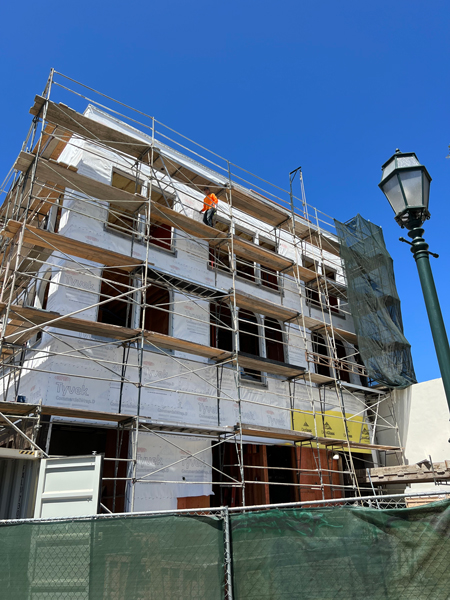
“Basically, now we have an entire concrete building inside the old brick building, which we then attached to the shotcrete with No. 5 dowel pins every 18 inches on center over the entire inside surface so that the brick is now just an adhered veneer to the concrete.” Edwards said they had to hold up the old structure while they removed areas to install steel and concrete.
“At some points, the original floor plates were being suspended on shoring while the exterior brick walls were cut loose and not attached to anything so we could put the steel in the concrete up on both sides,” he said, adding that the floor plates were then attached to the concrete, and the concrete attached to the brick through the shotcrete process.
“You’d never know how much work went into this building because it’ll blend right in with everything,” Dunn said.
The building also has a sophisticated stormwater management system. The city requires that stormwater be managed on site, Edwards said, which presented a challenge since the building essentially extends from one property line to the next. After exploring several options, they created a gravity-based detention system underneath a slab in the lowest part of the building, which included installing 40-foot caissons that go down into the bedrock.
“So we basically built a pier at one end of the building, and underneath it is all of our detention chambers, which then handle the stormwater management,” he said.
Dunn said the system they installed is preferable to a mechanical one because there is far less maintenance involved.
“If you stay away from mechanical systems and do gravity fed into the ground — detention facilities for the stormwater — then we can keep all of their rainwater and it’s filtered on site and goes into the ground on site,” he said. “That’s what we try to do, and Mark’s team has done a beautiful job where it is very difficult when the building takes up 100% of the property.”
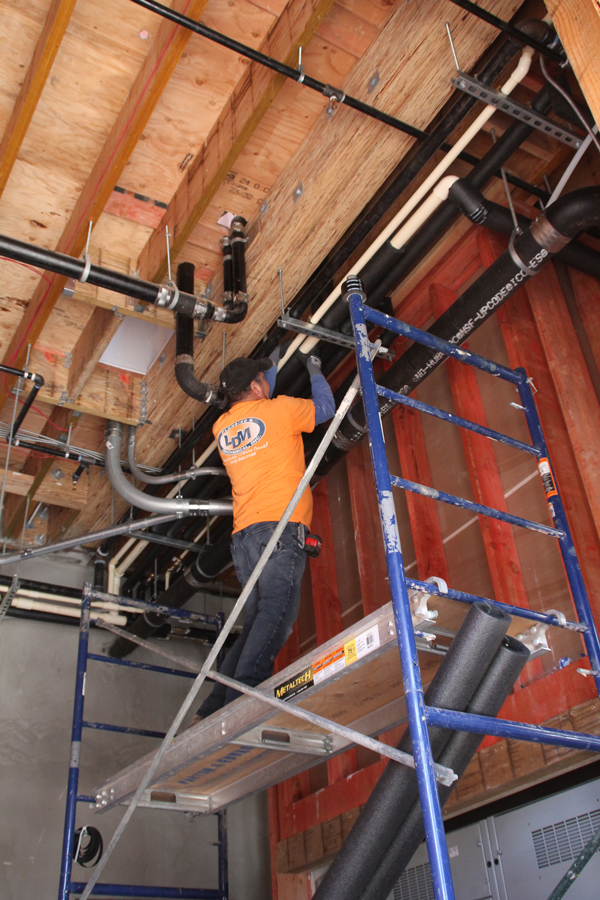
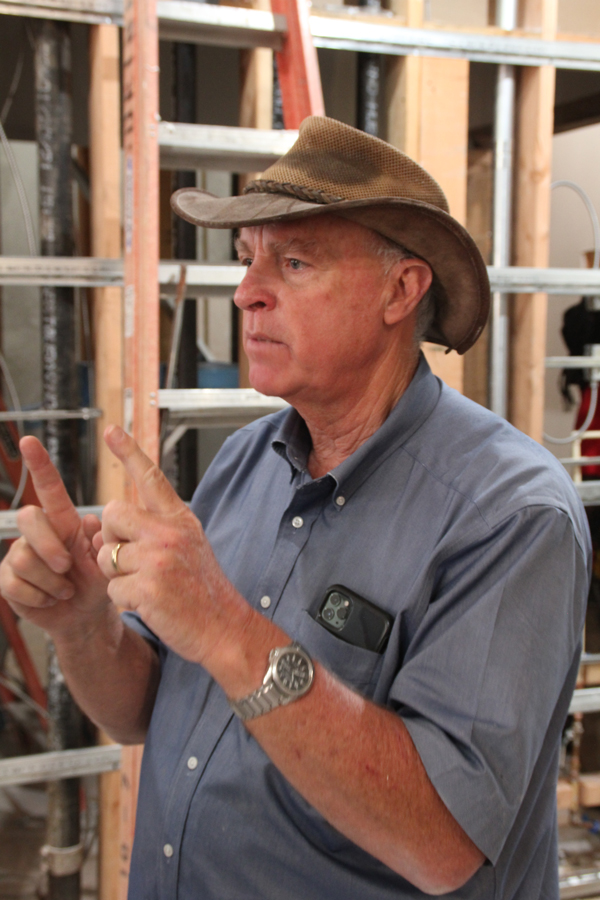
MONTECITO MUDSLIDES
The drive from the second stop to the third traversed through the Montecito, which is known as a celebrity enclave whose residents include Oprah Winfrey, Prince Harry and Meghan Markle, Rob Lowe, and Ariana Grande. The city of Santa Barbara handles inspections for Montecito’s business district, while the remainder of the 8-square-mile town is under the county’s authority.
The deadly mudslides in January 2018 occurred less than a year after Dunn had begun working for the city. Dunn pointed out places where the streets were full of 3-and 4-foot-tall walls of mud with large boulders and all of the electrical poles had been knocked down.
“For months we couldn’t get any clean water into this area so we worked with the health department and we allowed tank trucks to come in for the businesses,” he said. “If businesses wanted to open up, they would have to get water tanks with pumps to feed the business with potable water. You don’t realize how important a safe potable water system is until you don’t have it.”
LOS AGAVES
The third inspection site was the home of a former Dunkin’ Donuts being converted into a Los Agaves, a popular Mexican food restaurant chain. Construction is being done by Evans Construction, and Superintendent James Garrows is overseeing the project. Dunn said the plumbing and underground inspections had already been conducted, and the duct systems and hood would be tested later in the week.
He said one of the biggest potential hazards for which he looks is making sure the hoods and connections and installed properly. He said he likes to get on the hoods because the hangers are supposed to be sized to accommodate a human body as well as the weight of the hood. He also checks the connection of the grease duct to the hood because he finds that shoddy welding often leads to leaks there.
“That is really bad because that’s where the fire goes up from the ovens,” he said.” And if there’s grease thrown up into a shaft or into an area that’s concealed, that’s how the building catches on fire. That’s why one of the most important things — this is number one for me for inspections — is hoods and connections.”
Dunn also highlighted the importance of dampers and said Santa Barbara requires a damper stroke test.
“We also do a smoke test,” he said. “They’ll do smoke in a can, and we will test the dampers to make sure they shut down.”
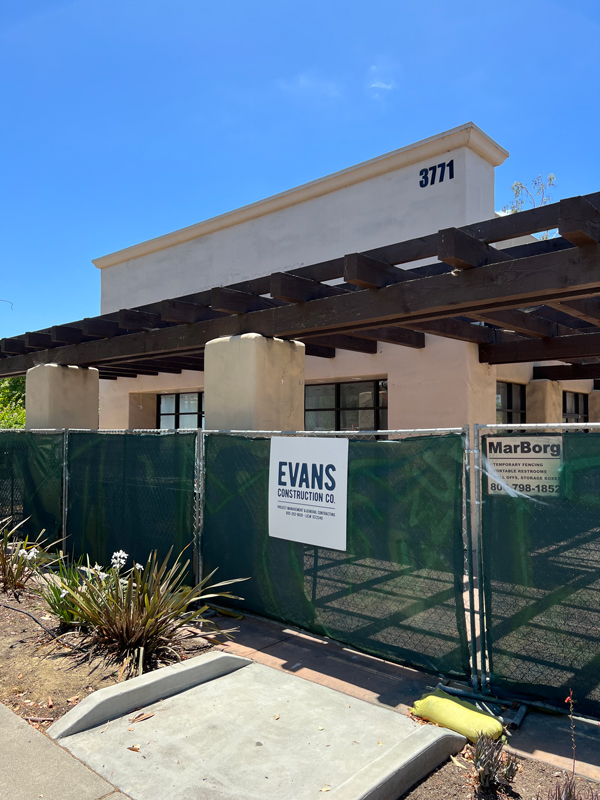
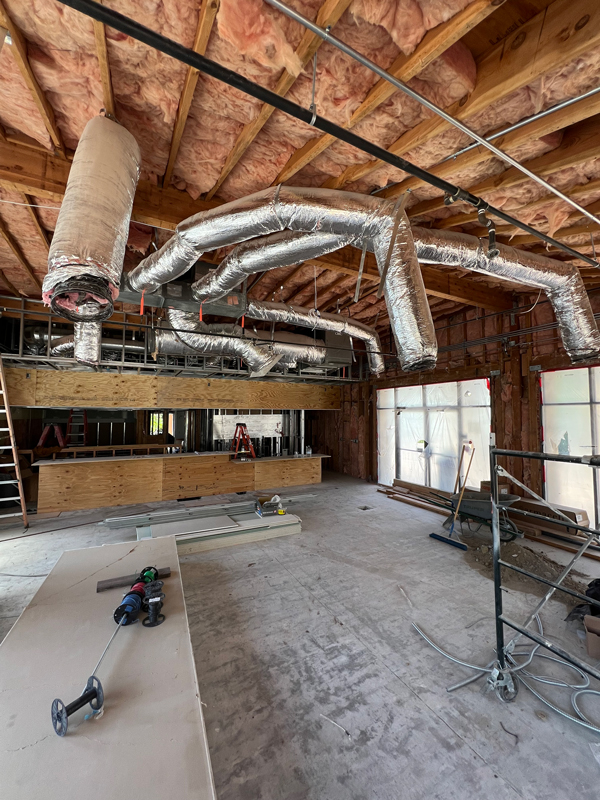
One thing Dunn said the inspection flagged was the presence of a mop sink going into the grease trap, which is not allowed because the soaps loosen up the oils. Instead of staying in the grease trap, they will run right through the grease trap and solidify into the city main.
“They had to go back into the waste system and reroute the mop sink so it goes into the normal sanitary sewer,” he said. “So we have our sanitary sewer line, and then we have our grease waste line, which will be our three-compartment sink.”
Dunn said the Wastewater Compliance Specialist Tom Mozako would test the grease traps to make sure they are functioning properly.
“(Mozako) also has an eyeball where he can see whether or not it’s going,” Garrows said. “He can see water. If it goes in the grease trap, there are two cleanups — one there for the sewer and one here for the grease.”
“I’m not going to be here, so if you do a water test and Tom observes you have no leak, then you can cover,” Dunn said. “I don’t want to hold you up.”
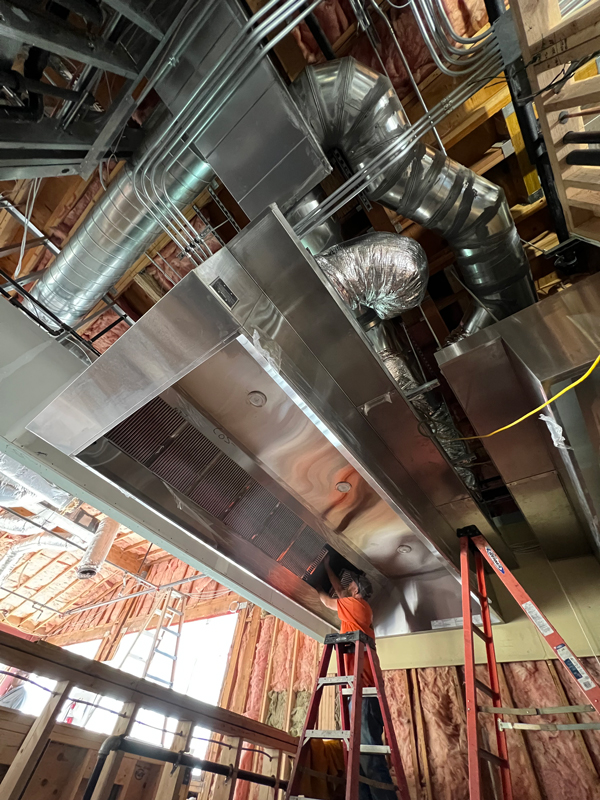
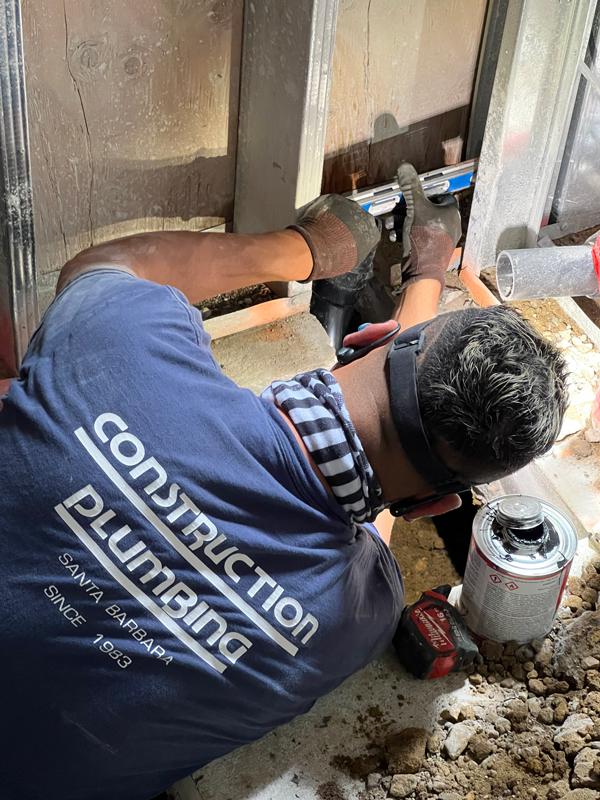
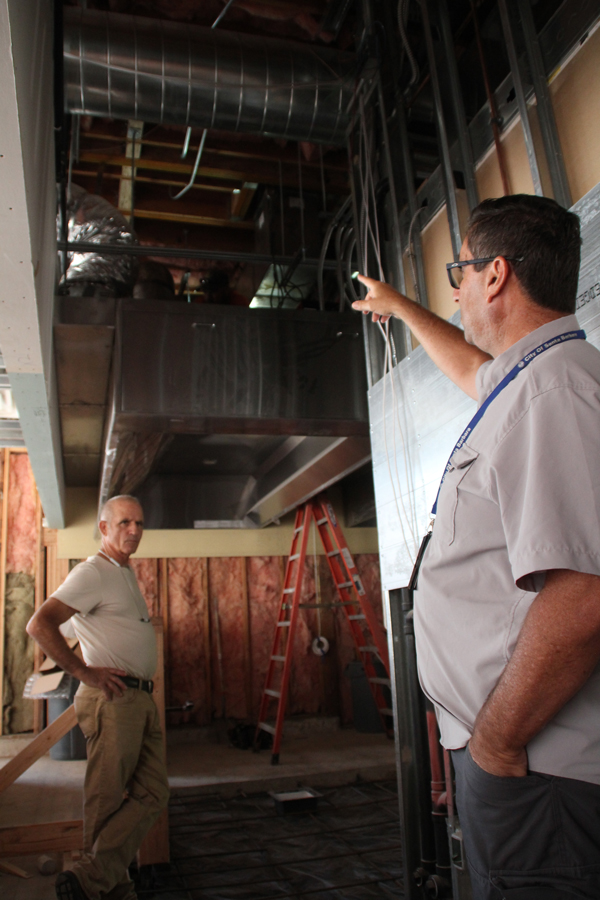
Unique and Challenging
Back in the office, Chief Building Official Tina Dye discussed aspects of the city’s Building & Safety Division that set it apart from similar departments, as well as challenges her team faces.
She came to Santa Barbara in January 2020 after more than two decades with the city of Pismo Beach on California’s Central Coast. Dye highlighted the use of specialists as something that is fairly unique to the city of Santa Barbara.
“I feel like there’s a lot more detail given to specific trades and therefore probably a higher-quality review and inspection,” she said. “I think that’s definitely something that stands out.”
Dye said the city also has a performance measuring system that challenges inspectors to perform high-quality inspections in as timely a manner as possible.
“I’m really proud of the team that we have here because they manage to do that as well as work on process improvements and provide really good, detailed service for their individual trades,” she said.
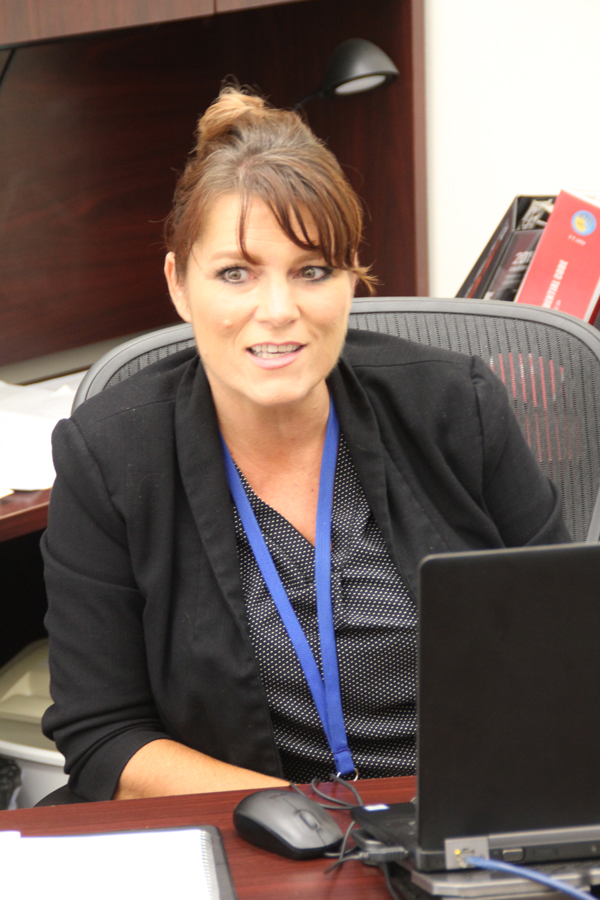
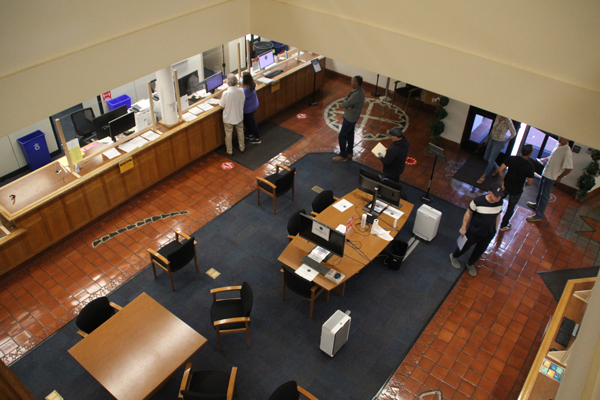
Dunn said another way in which the city is unique is that unlike other places he has worked, the code compliance team has inspectors who are certified by the California Association of Code Enforcement Officers (CACEO). “I think we can give a lot of insight with having code enforcement officers who are inspectors,” he said.
The city recently combined the Zoning and Building & Safety enforcement divisions, and while it is a work in progress, Dye said the goal is to have the zoning compliance officers familiar enough building codes to do both, and vice versa for Building & Safety staff.
“I think that’s kind of unique for Santa Barbara too, that the Planning and Building & Safety code compliance teams are together,” she said.
Dye echoed Dunn’s statements that staffing levels continue to be a challenge. She cited an overall deficiency in the industry, saying that on the whole there are not enough people learning what being a code official is all about. When she was with Pismo Beach, she said they would reach out to architectural and structural engineering students at nearby Cal Poly San Luis Obispo to let them know how lucrative a career it could be.
“We have over 25% vacancy here in our inspection and code compliance team,” she said. “So that’s a really big challenge for us right now to keep up with the level of service that the city expects from us, and the public expects from us and do a really good job.”
As for trends, Dye said the city is always looking for ways to improve services, a large part of which involves staying current with the latest technology. That also includes seeking and receiving stakeholder input from their highly involved citizenry.
The city created a sustainability department within the past few years, and she expects more ordinances like the natural gas ban to be enacted in the future, which go beyond minimum requirements.
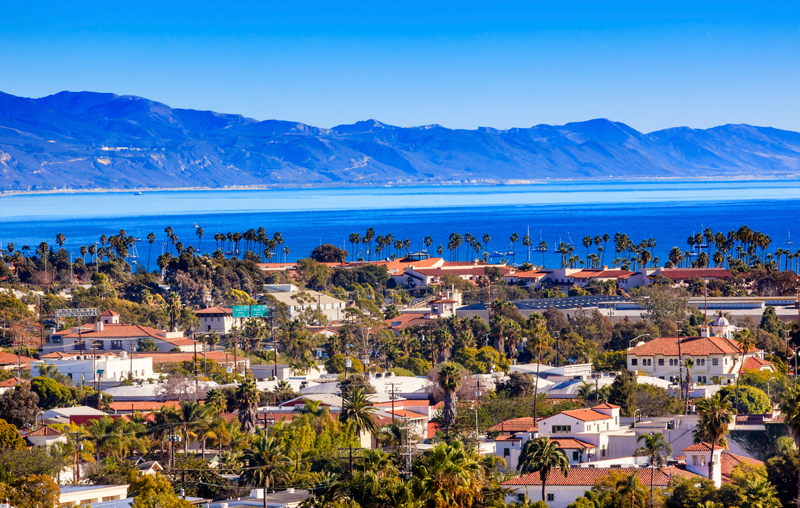
“I can see us moving more and more toward more stringent codes,” she said, “which is hard, because we have a ton on our plate already.”
Although Dye came to Santa Barbara as a contract employee not planning to apply for the position permanently, she got excited about the opportunities she saw to improve the ways in which the division serves the public and threw her hat in the ring.
“I’ve grown a lot in this position just because of the unique citizens we have here,” she said. “Yes, they’re very unique,” Dunn said.
“We’re regulatory, but we’re also trying to be very customer friendly,” Dye said. “So that gives us an opportunity to evaluate our program and kind of tailor it to meeting code minimums while also looking for ways we can help.”

Mike Flenniken is a staff writer, Marketing and Communications, for IAPMO. Prior to joining IAPMO in 2010, Flenniken worked in public relations for a group of Southern California hospitals and as a journalist in writing and editing capacities for various Southern California daily newspapers.
Last modified: May 8, 2024
